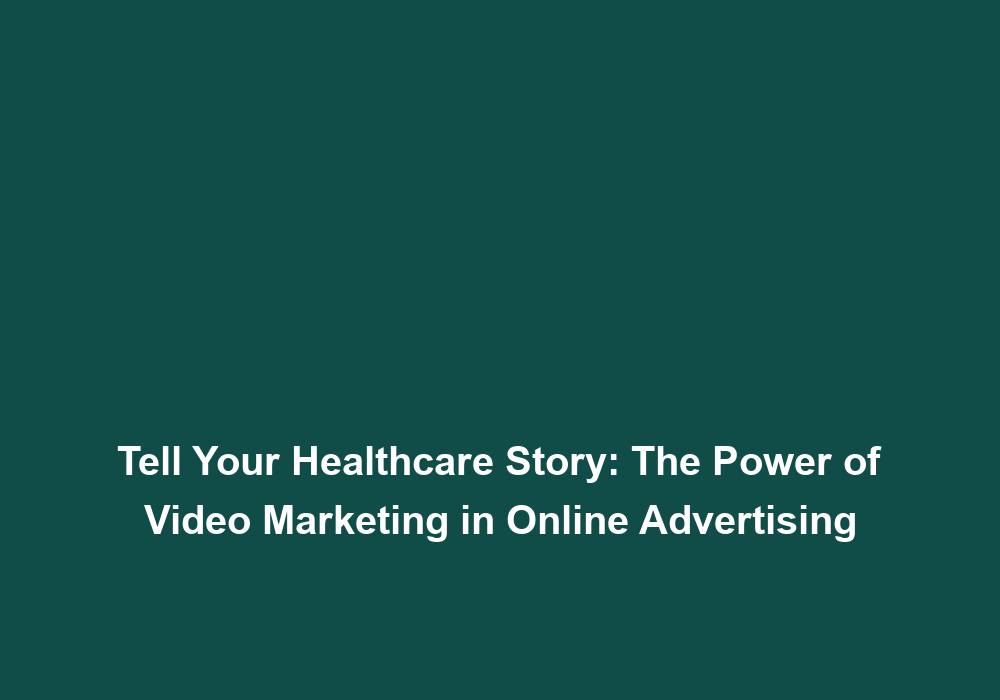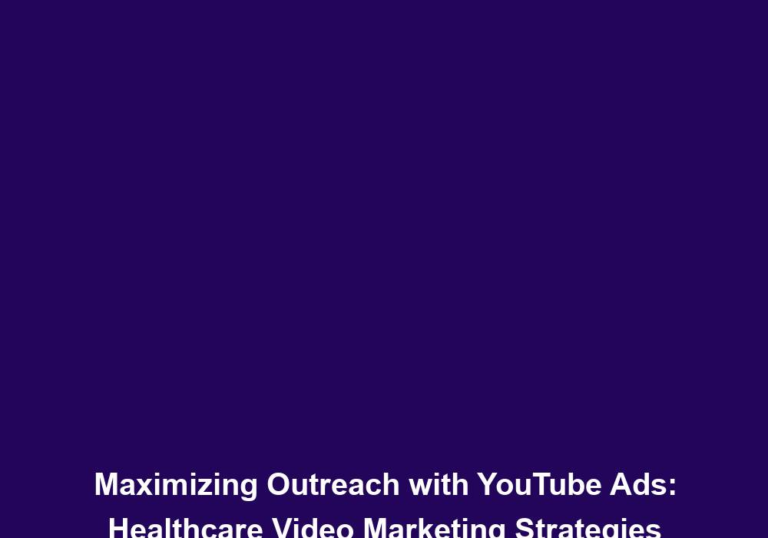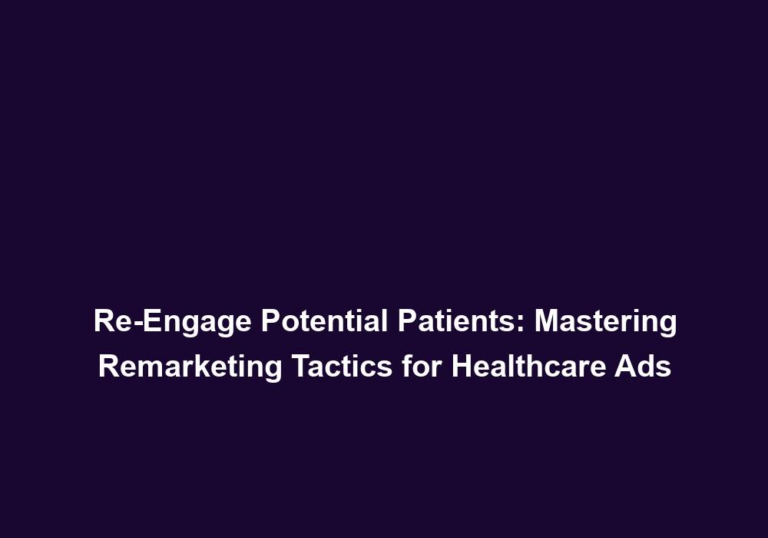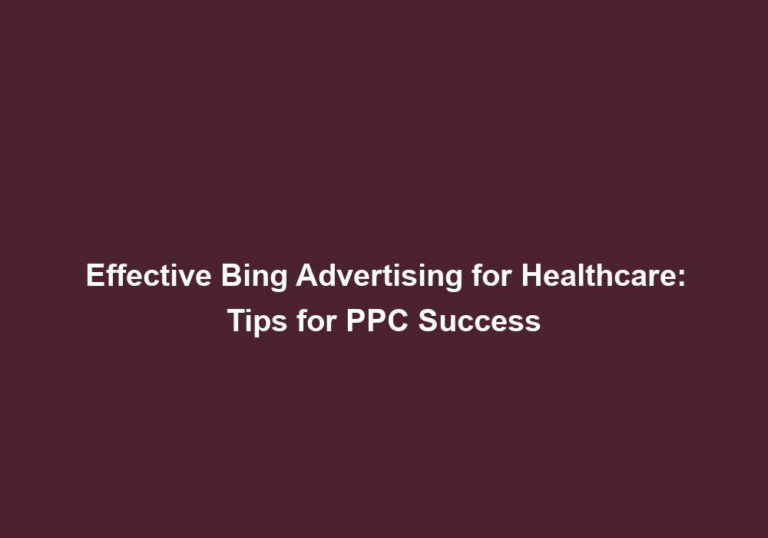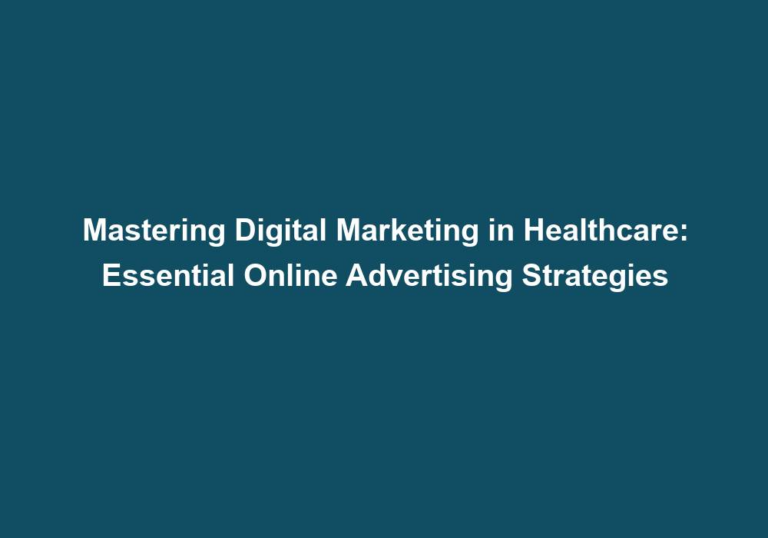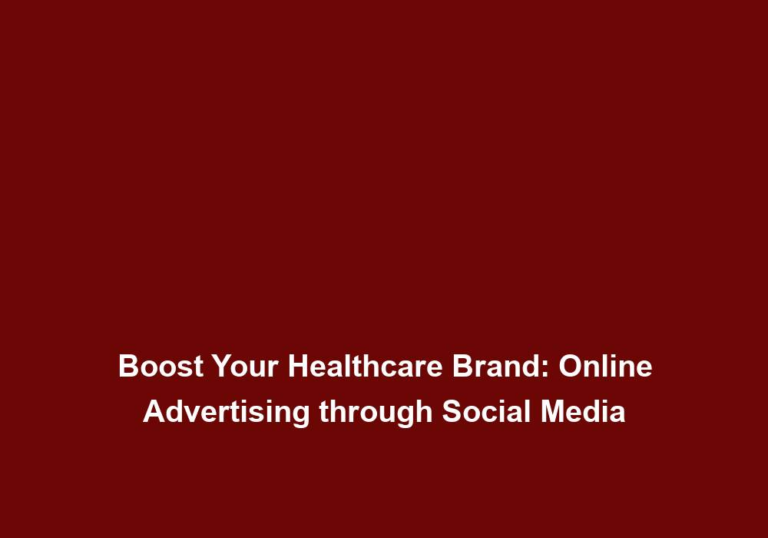Tell Your Healthcare Story: The Power of Video Marketing in Online Advertising
In today’s digital age, video marketing has emerged as a powerful tool for businesses across various industries, including healthcare. With the rapid growth of online platforms, videos have become an effective way to engage and connect with audiences. This article will explore how healthcare providers can harness the power of video marketing in their online advertising strategies.
Why Video Marketing Matters in Healthcare
- Enhancing Patient Engagement: Videos have the potential to captivate and connect with audiences, making them an invaluable resource for healthcare providers seeking to engage patients. By sharing compelling stories, educational content, or showcasing their facilities and services, healthcare providers can effectively communicate with patients and create a more personalized experience.
Videos can go beyond traditional written content and provide a more immersive and engaging experience for patients. By using visual and auditory elements, healthcare providers can create emotional connections with their audience. This can result in increased patient engagement, as well as a deeper understanding and connection with the healthcare provider.
In addition to engaging patients, videos can also be used as a tool for education. By presenting information in a visual format, healthcare providers can simplify complex medical concepts and make them more accessible to patients. This can empower patients to take an active role in their healthcare decisions and improve overall patient outcomes.
Furthermore, videos can also be used to showcase the facilities and services offered by healthcare providers. By providing a virtual tour of the facility or highlighting specific services, patients can get a better sense of what to expect and make more informed decisions. This can lead to increased patient satisfaction and loyalty.
- Improving Brand Awareness: Video marketing offers a unique opportunity to showcase a healthcare provider’s brand and values. By crafting engaging and compelling videos, providers can create a memorable impression on their target audience and differentiate themselves from competitors.
Videos can help healthcare providers establish a strong brand presence by effectively communicating their mission, values, and unique selling points. By creating videos that resonate with their target audience, healthcare providers can build brand awareness and loyalty.
In addition, videos can also be shared on various online platforms, such as social media, websites, and video sharing platforms. This can increase the reach of the healthcare provider’s message and attract a wider audience. By consistently creating and sharing high-quality videos, healthcare providers can establish themselves as industry leaders and attract more patients.
- Building Trust and Credibility: Healthcare decisions are often driven by trust and credibility. Videos provide an excellent platform for healthcare providers to share testimonials, success stories, and expert advice. By demonstrating their expertise and highlighting positive patient experiences, providers can build trust and establish themselves as credible sources of information.
Testimonials from satisfied patients can be incredibly influential in building trust and credibility. By sharing real-life stories of patients who have had successful outcomes or positive experiences with a healthcare provider, potential patients can see the impact of the provider’s services. This can help alleviate any concerns or doubts that potential patients may have and increase their confidence in the provider.
In addition to testimonials, videos can also feature interviews with doctors and staff members. By showcasing the expertise and qualifications of the healthcare team, providers can establish themselves as trusted sources of information. This can help patients feel more confident in seeking care from the provider and lead to increased patient satisfaction.
- Educating and Informing: Videos allow healthcare providers to educate and inform patients about various medical conditions, treatments, and preventive care. By creating informative videos, providers can empower patients to make informed decisions about their health while positioning themselves as trusted sources of information.
Educational videos can cover a wide range of topics, from explaining medical procedures to providing tips for maintaining a healthy lifestyle. By presenting information in a visual and engaging format, healthcare providers can effectively communicate complex concepts and increase patient understanding.
Furthermore, videos can also be used to address common misconceptions or myths about certain medical conditions or treatments. By debunking myths and providing accurate information, healthcare providers can play a crucial role in promoting health literacy and empowering patients to make informed choices.
- Increasing Online Visibility: Online video content has shown to improve search engine rankings and increase organic traffic. By incorporating video content into their online advertising strategies, healthcare providers can enhance their visibility in search engine results and attract more potential patients.
Search engines, such as Google, prioritize video content in search results, as it provides a richer and more engaging experience for users. By optimizing video content with relevant keywords, descriptions, and tags, healthcare providers can increase their chances of appearing in search results and driving organic traffic to their website.
In addition, videos can also be shared on social media platforms, which can further increase visibility and reach. By creating shareable and engaging video content, healthcare providers can leverage the power of social media to attract a wider audience and drive traffic to their website.
Types of Videos for Healthcare Marketing
- Patient Testimonials: Sharing real-life stories of patients who have had successful outcomes or positive experiences with a healthcare provider can be incredibly influential. Testimonials humanize the healthcare experience and help potential patients relate to the provider’s services.
Patient testimonials provide a powerful way to showcase the impact of a healthcare provider’s services on real people. By featuring patients who have achieved positive results or experienced exceptional care, potential patients can see the value and benefits of choosing the provider. These testimonials can create an emotional connection and build trust with the audience.
To make testimonials even more impactful, healthcare providers can include specific details about the patient’s condition, the treatment received, and the outcomes achieved. This can help potential patients identify with the testimonial and visualize themselves benefiting from the provider’s services.
- Facility Tours: Videos showcasing the facilities, equipment, and amenities of a healthcare provider can give potential patients a virtual tour and help them feel more comfortable and confident in their choice of provider.
Facility tours provide an opportunity for healthcare providers to showcase their state-of-the-art facilities and highlight the quality of care they provide. By taking viewers on a virtual tour, healthcare providers can create a sense of familiarity and transparency.
During the facility tour, healthcare providers can highlight key features and services, such as specialized equipment, comfortable waiting areas, or advanced technology. This can help potential patients visualize themselves receiving care in a welcoming and modern environment.
In addition, facility tours can also include interviews with staff members, allowing potential patients to get a glimpse of the healthcare team and their expertise. This can help establish a personal connection and build trust with the audience.
- Educational Content: Creating videos that educate patients about medical conditions, treatment options, and preventive care can position healthcare providers as knowledgeable experts. By providing valuable information, providers can build trust and establish themselves as reliable sources of medical advice.
Educational videos can cover a wide range of topics, from explaining common medical conditions to discussing the latest advancements in healthcare. By presenting information in a clear and accessible manner, healthcare providers can empower patients to take an active role in managing their health.
To ensure the effectiveness of educational videos, healthcare providers should focus on providing accurate and evidence-based information. They can also use visual aids, such as animations or infographics, to simplify complex concepts and improve patient understanding.
Furthermore, healthcare providers can also address frequently asked questions or common concerns in their educational videos. This can help alleviate any doubts or fears that potential patients may have and position the provider as a trusted source of information.
- Doctor and Staff Interviews: Introducing the healthcare team through video interviews can personalize the provider’s brand and create a sense of familiarity. Patients are more likely to feel comfortable seeking care from professionals they feel they know.
Doctor and staff interviews provide an opportunity for healthcare providers to showcase their expertise, qualifications, and passion for patient care. By allowing doctors and staff members to share their stories and insights, potential patients can get a glimpse of the provider’s values and commitment to delivering high-quality care.
During the interviews, healthcare providers can discuss their areas of specialization, experience, and treatment approaches. This can help potential patients assess whether the provider is the right fit for their specific healthcare needs.
In addition, doctor and staff interviews can also highlight the provider’s bedside manner and interpersonal skills. By showcasing their ability to connect with patients on a personal level, healthcare providers can build trust and instill confidence in potential patients.
- Live Q&A Sessions: Hosting live video sessions where healthcare providers answer patients’ questions in real-time can foster engagement and create a sense of community. This interactive approach allows providers to address concerns directly while establishing their expertise.
Live Q&A sessions provide a unique opportunity for healthcare providers to engage with their audience in real-time. By allowing patients to ask questions and receive immediate responses, providers can demonstrate their knowledge and expertise.
During the live sessions, healthcare providers can address common concerns, provide clarification on medical topics, and offer personalized advice. This can help build a sense of trust and credibility with the audience, as they can see the provider’s commitment to patient education and support.
To maximize the impact of live Q&A sessions, healthcare providers can promote the sessions in advance and encourage patients to submit their questions ahead of time. This can help generate anticipation and ensure that the session covers relevant and valuable information for the audience.
Best Practices for Healthcare Video Marketing
- Keep it concise: Attention spans are shorter than ever, so it’s crucial to keep videos concise and engaging. Aim for videos that are around 1-3 minutes long, focusing on the most important points.
When creating videos, healthcare providers should prioritize brevity and clarity. By keeping videos concise, providers can deliver their message effectively and hold the viewer’s attention. It’s important to focus on the most relevant and impactful information, avoiding unnecessary details or lengthy explanations.
To ensure that the video remains engaging, providers can use visual aids, such as graphics or animations, to support the information being presented. This can enhance the viewer’s understanding and retention of the content.
- Tell a compelling story: Storytelling is a powerful tool in video marketing. Craft narratives that resonate with the audience, focusing on the human aspect of healthcare experiences.
To create a compelling story, healthcare providers should focus on the emotional impact of their services on patients’ lives. By highlighting real-life experiences and showcasing the transformational power of healthcare, providers can captivate and engage their audience.
In addition to patient stories, providers can also incorporate their own journey and passion for healthcare into their videos. This can help humanize the brand and create a connection with the audience.
- Optimize for SEO: Just like written content, video content should be optimized for search engines. Use relevant keywords in titles, descriptions, and tags to improve discoverability.
To improve the visibility of video content, healthcare providers should optimize their videos for search engine optimization (SEO). This includes using relevant keywords in titles, descriptions, and tags.
In addition, providers should also include a transcript of the video content to make it more accessible to search engines. This can improve the chances of the video appearing in search results and increase organic traffic to the provider’s website.
- Include clear calls-to-action: Whether it’s encouraging viewers to visit the website, book an appointment, or subscribe to a newsletter, always include clear and actionable calls-to-action in your videos.
To drive desired actions from viewers, healthcare providers should include clear and compelling calls-to-action in their videos. This can be done through visually appealing graphics or text overlays that prompt viewers to take the desired action.
In addition to including calls-to-action within the video, providers should also include relevant links or contact information in the video description or caption. This makes it easy for viewers to take the next step and engage with the provider.
- Leverage social media: Social media platforms provide an excellent opportunity to share and promote video content. Create a comprehensive social media strategy to maximize the reach of your videos.
Social media platforms, such as Facebook, Instagram, and YouTube, offer a wide range of features and tools to promote video content. Healthcare providers should leverage these platforms to reach a larger audience and increase the visibility of their videos.
To maximize the impact of video content on social media, providers should develop a comprehensive social media strategy. This includes creating a content calendar, optimizing video thumbnails and captions, and engaging with the audience through comments and messages.
Furthermore, providers can also collaborate with influencers or partner with relevant organizations to amplify the reach of their video content. This can help increase brand awareness and attract a wider audience.
- Monitor and analyze performance: Regularly review video metrics and analytics to understand viewer engagement and identify areas for improvement. Use this data to refine your video marketing strategy and optimize future content.
To ensure the effectiveness of video marketing efforts, healthcare providers should regularly monitor and analyze video metrics and analytics. This includes tracking metrics such as views, engagement rate, and conversion rate.
By analyzing video performance, providers can gain valuable insights into viewer behavior and preferences. This data can help identify areas for improvement, such as video length, content topics, or production quality.
In addition, providers should also pay attention to viewer feedback and comments to gather qualitative insights. This can help identify any gaps or opportunities for improvement in the video content or messaging.
In conclusion, video marketing has become an invaluable tool for healthcare providers to engage patients, build trust, and increase their online visibility. By leveraging various types of videos and following best practices, healthcare providers can effectively communicate their story, educate patients, and ultimately drive success in their online advertising efforts.

